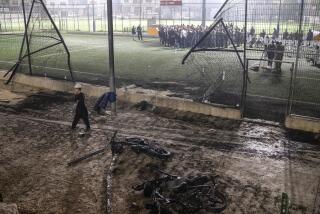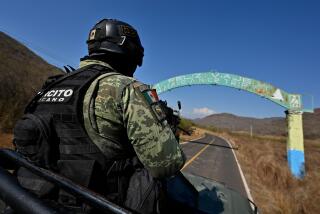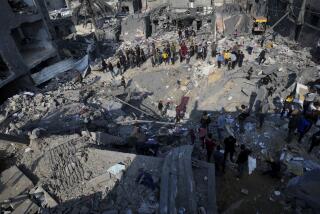Master Blasters Detonate Dangers
- Share via
BAGRAM, Afghanistan — Just minutes into the workday, the Explosive Ordnance Disposal team ran into its first perilous dilemma: The Afghan villagers wanted to keep their rocket.
The 122-millimeter, Soviet-made white tube of high explosives was lying half inside the perimeter of the base here that U.S. forces control along with anti-Taliban fighters, and half in one of the numerous villages around the field. A dozen children were crowded around, poking it. A village elder said he wanted to keep it.
“We’ll take it if they want, but it’s their rocket,” Army Sgt. Mike Barker said with a shrug. “It’s dangerous for everybody, on the base and in the village, but we can’t take their rocket just because we think it’s a good idea.”
The local Northern Alliance commander, Khawani, soon appeared, overruled the elder and asked the Americans to dispose of the rocket. After deciding that it was safe because it didn’t have a detonator, Barker and two of his counterparts loaded the rocket into their Humvee and headed down the road.
Two minutes later, they spotted an unfired air-to-air missile lying in the dirt.
For the soldiers of the Explosive Ordnance Disposal, or EOD, team here, it was just another day, another artillery shell, another cluster bomb, some missiles, some mines and the rocket.
The American team is one of several such units in Afghanistan, units from coalition countries that, like the U.S., are trying to make the nation a bit safer even as they continue to fight Taliban and Al Qaeda forces.
Disposing of such hazards falls to a unique group of soldiers, every one of whom applied for the job and studied hard, in a field with a more than 50% failure rate, to get it. In the U.S. and many other nations’ militaries, soldiers cannot be assigned to an ordnance disposal unit.
The dangers they face can be extreme: Whereas most minefields in this ravaged country are marked, there are no flags pointing out other deadly detritus of war.
This 744th EOD unit from Ft. Meade, Md., like many of those from other nations, is not a demining team. Under U.S. military code, de-mining is left to nongovernmental organizations.
The EOD unit handles mines only if they are in the team’s immediate way. Its job here is to gather everything that could explode, wrap the munitions in other explosives and blow the whole mess up.
As Afghans, U.S. soldiers, international peacekeepers and aid workers begin moving into abandoned battlegrounds--some deserted for a decade, others for a few days as the fighting continues--ordnance teams are being employed as never before.
British experts are rushing to clear five sites in the capital, Kabul, before 4,500 peacekeepers arrive by the end of the month. French and Jordanian troops are helping clear areas around the northern city of Mazar-i-Sharif.
“This stuff is everywhere, absolutely everywhere,” Sgt. 1st Class Robert Breaux said. “Many of the minefields are marked with wire. This stuff isn’t marked.”
Bagram Base Is Especially Hazardous
After more than two decades of war, Afghanistan is so littered with high explosives that about five Afghans die or are maimed each day, according to the International Committee of the Red Cross.
As the conquering armies have laid mines, then fled, with their conquerors then laying their own, the minefields have become ubiquitous. Over the years, however, Afghans have learned to navigate local minefields with ever more caution, relative though it may be, and the toll in lives and limbs is believed to be down from a decade ago.
But unexploded ordnance--rockets, antiaircraft and recoilless rifle rounds, and bombs made by the Soviets, U.S., China and Germany--poses a unique threat, especially now, as people begin to move about again.
The fixed firing positions of yesterday’s fighters can be located, but no one knows where the rounds they launched landed. The same is true with air-delivered ordnance, which can miss its target by miles. Thousands upon thousands of munitions were left during retreats, advances and flanking maneuvers. Munitions stockpiles were rocketed, blasting detonated and undetonated rounds out for hundreds of yards like so much shrapnel.
“The bases are not yet safe,” British military spokesman Guy Richardson said Thursday of the Kabul posts. “EOD operations are continuing.”
Bagram, the largest air base in the country, is a study in the perils and problems facing Afghanistan in terms of unexploded ordnance.
Bagram, about 20 miles north of Kabul, has been a battlefield almost since it was built in 1976. Between 1999 and the end of 2001, the field changed hands several times.
Enter the main gate at Bagram, look to your right, and there’s a Soviet rocket pointing right at you. No one has retrieved it yet because 10 yards in one direction is an antitank mine, 10 yards in another is an antipersonnel mine, with several antiaircraft shells scattered around.
Look to the left and you’ll see a hole in a concrete guard shack. That’s where the EOD types pulled out a recoilless rifle round, essentially an armor-piercing rocket-propelled grenade minus the rocket engine.
One recent day, long after the Air Force’s small encampment had been swept repeatedly for dangers and the airmen had settled into their tents, a forklift rolled in. When it rolled back out, up popped a Soviet F-1 hand grenade.
“Whoa, whoa, whoa, whoa, whoa!” a chorus of onlookers shouted when a lieutenant in a hurry nearly stepped on it.
It takes a special kind of soldier to do the job--which helps explain the excitement in Staff Sgt. Doug Combs’ voice as he stood recently amid tens of thousands of pounds of munitions at a demolition site in Bagram’s vast desert.
“This is the largest bunch of ordnance I’ve seen in 16 years on the job, by a mile!” the 40-year-old exclaimed. “This is the opportunity of a lifetime.”
Experts Inspect Unusual Weapons
The best way to destroy any munition is to blow it up in place. Most of the time here, though, that’s not possible. People live too near, or the blast could destroy a road, or it’s stuck like a stake in the side of a building. So members of the EOD unit bring their finds to this collection site, among the earthen revetments that used to protect Soviet MIG-21 fighter jets.
Every few days, they stack some together, mold C-4 plastic explosives around the bunch, back off about half a mile and blow them apart. One recent blast took care of a pile of Soviet cluster bombs and the grenade from the Air Force camp.
But they don’t destroy everything.
Scattered about the collection area are hundreds of munitions of interest to U.S. intelligence and ordnance specialists. Some they’ve seen in books. Some they’ve never seen at all.
There is a row of 57-millimeter helicopter-launched rockets, an unusual recoilless rifle round with Chinese characters on it, a collection of 550-pound, Soviet-made photo-flash bombs designed to both kill the enemy and temporarily blind and stun those who survive.
One of the most intriguing finds is a slew of Soviet air-to-air missiles. The functional missiles are interesting enough, but what really piqued the interest of the EOD members were the training missiles--nonfunctional versions with stripped-away skin specifically designed as teaching tools.
How and why they were designed this way is right there for any trained eye to see.
“The intel guys can’t wait to get their hands on this stuff,” Combs said. “Thank you, Russians.”
Nearby are rows of cluster bombs, small, mostly shiny devices increasingly criticized by the international community that can be buried in snow or mud for years and detonated by the touch of a dog’s nose or a child’s hand.
Perhaps it was one of these, or maybe a small, buried mine, that took the foot of a British soldier a few weeks ago, and the foot of a member of the 744th a few days later.
Some in the village where they found the rocket believe that it was a mine or a cluster bomb that killed a 4-year-old girl named Ashka about a month ago. Others say it was a rocket, just like the one Khawani, the commander, turned over to the EOD unit to destroy.
“I fought the Taliban six years,” Khawani said. “I shot five rockets like this one at them at the last battle.”
More to Read
Sign up for Essential California
The most important California stories and recommendations in your inbox every morning.
You may occasionally receive promotional content from the Los Angeles Times.










